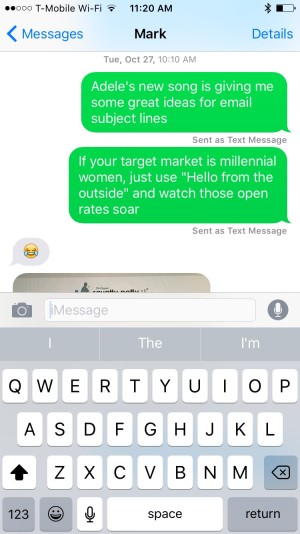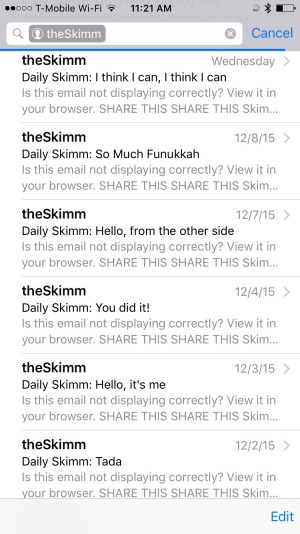The following is an actual text message exchange between my brother and I.

I know what you’re thinking. Who talks about email subject lines with their siblings? My brother works at Constant Contact and I own an inbound agency so this is something that happens. And yes, he did change the subject by telling me how excited he was to have just purchased his first squatty potty.
After this exchange, I knew it was just a matter of time before my favorite daily email had this same idea. A few weeks later, this happened:

TheSkimm is totally inside my head, and I love it. When I read their emails in the morning the voice that I read it in is the voice of my best friend. It sounds like we’re in college studying for an exam on current affairs and having a blast while doing so. They are such a perfect example of knowing your audience.
Mailchimp (sorry brother) posted a blog a while back about how they get to know their target personas. After gathering data from actual users, they created a handful of their target personas. But then they took it a step further. They created posters of each persona, complete with a portrait of them surrounded by a bunch of adjectives about that persona. They printed the posters and hung them up in their headquarters, so they are always thinking of them.
It just so happens that their “power user” persona has very similar characteristics to those of my husband and business partner, Fred. They even have the same name.

When he saw this, he was the opposite of creeped out. He was excited to see that the brand behind a product he loved, really knew him.
So how do you get inside the head of your target personas? Simply put, you have to listen. And I mean, not just listen, but like really listen. It’s not enough to know their age and income level, you have to get to know their struggles, passions, and even their language quirks.
When you meet with a great prospect who would be an ideal client for your company, take really great notes. Write down their questions word for word, and even pay close attention to the subjects they bring up that are unrelated to what you offer.
Put together a survey and send it out to your best clients. Encourage authentic, well thought out answers. Ask the people you know really trust you so that you know they’re 100% authentic.
Here are some tips from a HubSpot blog post for creating buyer personas.
- Look through your contacts database to uncover trends about how certain leads or customers find and consume your content.
- When creating forms to use on your website, use form fields that capture important persona information. For example, if all of your personas vary based on company size, ask each lead for information about company size on your forms.
- Take into consideration your sales team’s feedback on the leads they’re interacting with most. What generalizations can they make about the different types of customers you serve best?
- Interview customers and prospects, either in person or over the phone, to discover what they like about your product or service.
These are some great guidelines, but it’s up to you to take it even further like TheSkimm and MailChimp do. Become obsessed with you buyer persona and get inside their head.

